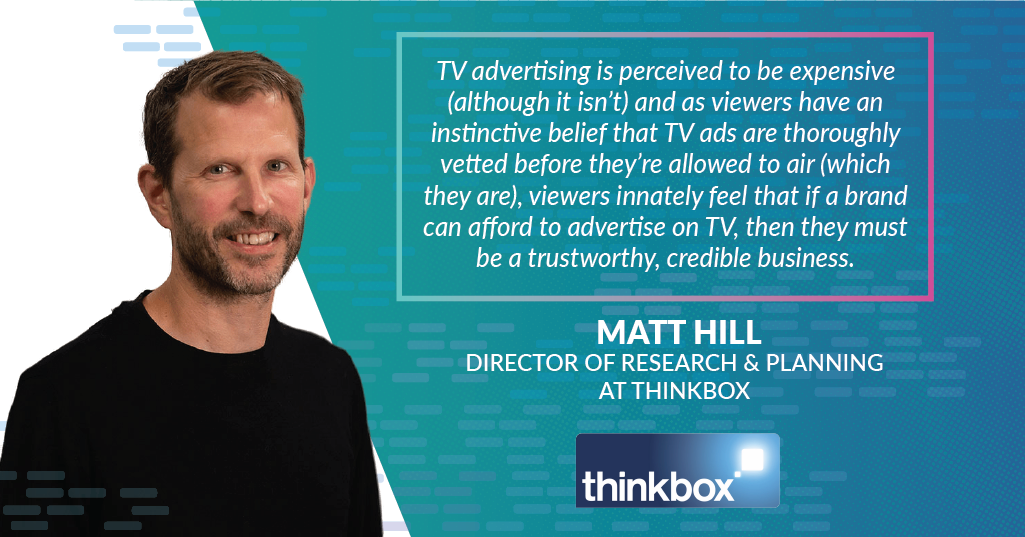HOW CAN TV ADVERTISING DRIVE GROWTH BEYOND ‘PERFORMANCE’ B2B MARKETING?
13. 11. 202313. 11. 20231) In recent times, targeted advertising on platforms like LinkedIn, Facebook etc. have become the go-to solutions for B2B companies when launching a product or service. What advantages do TV ads have over these types of campaigns?
Trust, credibility, and the time required to get across a product or brand message. For many marketing objectives, 6 seconds of video or a static display ad isn’t enough to get across the message that a business needs to tell customers. More time is often required to explain your business or product proposition, or to change their perception of your brand.
Most importantly, great story-telling creative can build an emotional connection between a person and your brand, which has been proven time and again to be the best way to prime people so that, when they are eventually in-market for your product, they’re more likely to consider you.
2) Company owners have a relatively small amount of time to watch TV, what would you say to CEOs or Marketing Managers who question the value of TV when reaching busy decision-makers?
Number one, check the facts on viewing levels. The average 35-64 year old (who I’ve guessed as proxy group for ‘busy decision makers’) watched an average of 1hr 36 mins of commercial TV a day in April 2023.
Two – don’t think of TV as only able to deliver blunt, mass audiences. Broadcaster video on demand and the ability to insert addressable ads into live TV is now a scalable reality for advertisers. The broadcasters all sit on huge volumes of first party data, which they can use with other data sources (i.e. Mastercard/Experian) to target specific audiences.
3) Recent statistics from your organisation show that in terms of Ad spend, TV advertising is more cost effective over social media platforms. Can you elaborate on this?
Yes, TV is much more cost effective than social channels for delivering a 30 second message. The average cost for a 30 second ad on TV is less than 1p – for social channels the equivalent cost is 13p. But it’s not an either or question, both channels work very well together; the effectiveness of social ad campaigns increases by 31% when they’re run alongside a TV campaign. Through building awareness, trust and warmth to your brand, TV can make other forms of advertising more effective as people are already primed to consider you.
4) What are the advantages of consuming advertising content on a big-screen at home over a desktop or mobile device?
TV advertising is a laid back and familiar experience to viewers, there’s a long-established value exchange where viewers are happy to accept the advertising in return for the content. Advertising on devices tends to be more intrusive and easier to avoid as people have more agency when using a tablet, mobile or PC. So, the advantage of advertising on TV is that it increases the chances of your ad generating the attention it needs to have its desired effect.
TV advertising also delivers what is known as a ‘costly signal’ – because TV advertising is perceived to be expensive (although it isn’t) and as viewers have an instinctive belief that TV ads are thoroughly vetted before they’re allowed to air (which they are), viewers innately feel that if a brand can afford to advertise on TV, then they must be a trustworthy, credible business. It’s the ‘as seen on TV’ effect – something that is magnified by being seen advertising alongside the biggest brands in the market.
5) Were there any findings from your organisation’s recent report ‘Trends in TV 22-23’ that surprised you?
The latest viewing data has shown that viewing to SVOD services like Netflix and Amazon prime video has declined, and viewing to the commercial broadcasters has stabilised. For the last five years the reverse has been true. SVOD subscriptions have fallen backwards, most likely driven in part by the cost-of-living crisis. But also, due to the change in their valuations on the stock markets, SVODs are less able to pile endless volumes of money into their content catalogues and as a result are seeing declines in viewing figures.
6) What would you say are the long-term brand awareness benefits of advertising on TV for B2B companies?
Research from LinkedIn has shown that B2B advertising works in pretty much the same way as B2C advertising: the primary driver of growth is reaching as many potential customers as possible and building an emotive connection with them, so they’re primed to consider your brand when they’re in market. TV is unrivalled at both these tasks; it has huge scale and allows advertisers the time needed to tell a story and build that all-important emotional connection.
Very few B2B business have a constantly churning pool of customers that would make high volumes of spend on ‘performance’ media the sensible option. In fact the opposite is true for B2B – infrequent purchase cycles mean that brand metrics are vital when it comes to growth.
Businesses that prioritise building their brand over time become less reliant on constantly having to attract customers through high-cost search advertising or promotions and offers. Building your brand makes it much more likely that customers come directly to you and saves huge volumes of money that are spent on point-of-sale channels.
Many thanks Matt, some great insights here about how SMEs can harness the power of TV.
Source: blackcliffmedia.com


